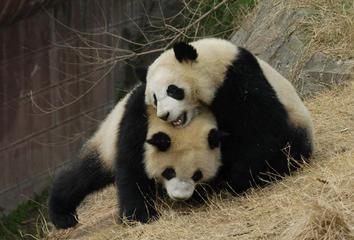How are baby Pandas made?
 Photo:
David Blank
Photo:
David Blank
Giant Panda Bears mate just like the other members of their family. They use certain scents to let females know that they would be a good mate for her. They also 'talk' to each other. Talking is called bleating. Certain sounds indicate a ready to mate male, which attracts females. Usually when there is a couple ready to mate, it makes other male Pandas competitive. Once other male Pandas get in the vicinity they create competition, and the original male might need to fight for his female mate.
Females in a sense are promiscuous. They are not monogamous. They require the best mate they can find, which may change every year. Giant Pandas mate in early summer, and usually give birth in September.
Because of the population of Giant Pandas decreasing, inbreeding is becoming more common. Inbreeding is also making the Giant Panda population decrease. Baby Pandas have a very small chance of survival and small chance of successful mating if they are inbred. Thankfully, certain parks and protected areas are trying to lessen the inbreeding. This is helping the population increase.
When a female is impregnated, she will gestate for an average of 135 days.
Once the mother is ready to give birth, she usually will find a cave to give birth in. Caves provide the much needed protection for the baby Panda. The mother and baby will stay in the cave for about a month. The mother might fast while she is taking care of her baby. The baby feeds on the mother's milk.
Mothers can give birth to one or two baby Pandas. Usually the weaker baby will be left to die since the mother can only take care of one with her Bamboo nutrition and milk supply.
Early Stages of a Baby Panda
 Photo:
David Blank
Photo:
David Blank
Birth - five months old: When a baby is first born, it is incredibly helpless and only weighs a few ounces. It suckles its mothers milk to get nutrition. It is furless and pink in the beginning months. It starts developing a fuzz a few months later. It makes a lot of noise, and its eyes are closed. In these early months, the mother will eat the baby's fecal matter and waste to keep the smell out and keep predators unaware of the baby.
Five - Six Months: The baby begins
to eat Bamboo. Mother still helps the baby along.
Eight - Nine Months: The mother starts weaning the baby off of her milk. This is in preparation of letting the baby go on its own.
Nine - Eighteen Months: The mother slowly keeps letting the baby grow and go on its own. The baby separates from the mother at 18 months.
The mother of the baby will not mate again for another one to two years after a healthy baby was born and has gone on its own.
Giant Pandas will begin to mate when they reach around four years old. They can live up to 20 years in the wild, and 30 in captivity. Photo: Shealah Craighead